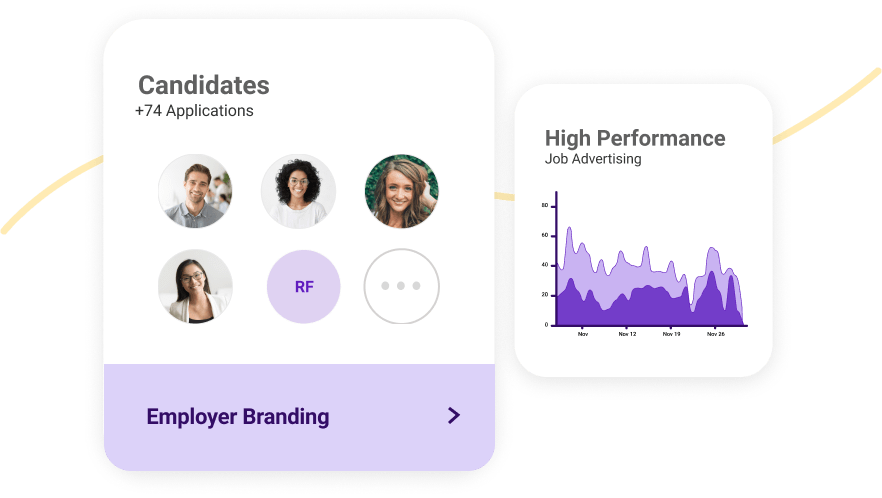Candidate Nurturing Essentials in High-Volume Recruiting
The sun is setting on the era of “post and pray” recruiting.
It has become more crucial than ever to engage in “pull” recruiting tactics instead of “push” ones. Borrowed from the dictionary of marketing, push tactics are an attempt to push an ad in front of someone. Pull tactics involve generating demand for something – in our case, pulling someone in to hit “apply.”
“Candidate nurturing” is a mix of both push and pull recruiting tactics. It’s another term borrowed from marketing (think lead nurturing). It describes the process of attracting, engaging, and converting candidates through targeted messaging across channels.
Nurture campaigns let you engage in consistent, yet gentle, communication over a longer period than the typical recruiting cycle. Though it’s often noted as useful for attracting passive candidates, it is a good strategy for your entire talent pool.
Nurturing is an important, and often underrated, piece of the high-volume recruitment process.
Benefits of Candidate Nurturing

In a job market where great talent is hard to find, and competition has increased considerably, candidate nurturing is more important than ever.
Here are reasons you should be focusing more of your high-volume efforts on nurturing.
Reduce your time to hire
The current world of recruiting is one where, across many industries, time to hire is increasing. Establishing a strong employer brand and using nurturing campaigns to target passive candidates is a great way to reduce your time to hire.
Nurturing allows you to stay engaged with:
- Current job applicants
- Previous employees
- Anyone interested in your brand or industry
Nurturing keeps a good conversation flowing even when you’re not hiring – or when job seekers are not looking. This makes it easier for when you do have open positions because you can recruit from a pool of people who are already interested.
Finding quality candidates and reducing time to hire are essential in high-volume recruiting. Achieve both with ease by keeping a more engaged talent pool with nurturing.
Hire for cultural fit
Candidate nurturing allows you to build a talent pool that is actively interested in what you have to say.
Nurture campaigns focus on sharing resources, opportunities, brand updates, and other relevant content. If this content is quality, you should get good engagement from your audience. The more engaged this audience is, the more likely they are to be a good cultural fit for your company.
Engaging in nurturing tactics keeps your talent pool strong.
Improve your candidate experience
Candidate nurturing isn’t just for passive candidates; it’s for everyone in your pipeline.
Any time you engage, delight, or educate someone, you are improving their experience. Providing personalization wherever possible makes them feel seen. Give them helpful and timely content to build and keep their brand affinity.
A positive candidate experience is most beneficial for applicants. They value speed and transparency and want to know the company they are applying to is a good one. It is also beneficial, however, for their network. If a candidate has a positive experience with your brand, they are more likely to recommend your company to a qualified friend, expanding your candidate pool further.
Candidate Nurturing Planning & Process

There is a lot of planning and thought that goes into the candidate nurturing process. Automation can help. But while automation may sound easy, you must do the groundwork of understanding your target candidate audience first. Once you do that, automation can be a great tool to keep manual work to a minimum.
Build candidate personas
Marketers create buyer personas to better segment their customers. They realize that it’s not just one type of person that uses their products, and not just one type that they could be targeting. So, they create custom “personas” – fictional characterizations of three-dimensional “people” that they learn to understand and effectively tailor content to.
This method can be applied to recruiting, too. Instead of buyer personas, build candidate personas that capture your target candidate audience.
A few things to consider when creating candidate personas:
- Age / years of experience
- Location
- Skill level
- Personality
Dive into your personas to learn what content strategy will resonate best with them.
Understand the recruiting funnel

In the list above, we left out what may be the most crucial factor to segment personas by: their stage in the recruiting journey.
In lead nurturing, prospects are segmented by their stage in the buyer’s journey. Here, you will want to break them down by their stage in the recruiting funnel. This allows you to tailor content to them based on where they are in their journey.
The funnel goes as follows: awareness, consideration, interest/application, hire.
At the top of the funnel, your content marketing should focus on awareness and consideration. Sell your employer brand and encourage prospects to follow your newsletter, social media platform, and brand across multiple channels.
For contacts who are already engaged with your brand, try a mix of resource sharing and employer highlighting. Share helpful career tips, content that is relevant to your industry, and any news or trends you see. This establishes you as a thought leader and a resource provider for everyone in your talent community, not just those who might one day apply.
Candidates who have applied to your job and are waiting to hear back should be treated with the utmost care. They have moved beyond the awareness and consideration stage. Candidates at this stage will want to know about things like your interview process and when they can expect to hear back from you.
Plan content to engage passive job seekers
One group of people that you should always keep an eye on are passive job seekers. You won’t want to shove job postings down people’s throats for those who aren’t actively looking. Instead, build a strong employer brand that shares helpful content. Create a positive presence that gets your talent pool invested.
Personalized content is crucial to a successful candidate nurturing strategy. Tailor relevant pieces to different personas and to the stage they’re at in the recruiting cycle. Meet with your marketing team to leverage their knowledge and effectively target the right prospects.
Highly-targeted candidate segments allow you to deliver content that delights your audience. The more they grow to like your brand, the more likely they are to apply for a job with you in the future.
Candidate Nurturing Methods

What high-volume nurturing tools should you have at your disposal?
Nurturing can take many forms, but here are the most important methods to master.
Use email automation
Automated nurture campaigns are the most common methods recruiters use. This involves triggering emails to be sent when a candidate takes a certain action.
So, for example, when a candidate applies to a job on your site, you can trigger an email that verifies that you received the application. Or, when someone downloads a gated piece of content, you can trigger an email to share another piece that they might enjoy.
This is the heart of candidate nurturing. The goal is to learn about a prospect’s behavior and use the knowledge to drive your content strategy, building a better brand experience.
You may have heard of “drip marketing campaigns.” These are like nurturing campaigns, but based on timing over personalization. Using tactics from both schools of thought – sending personalized messages while keeping timing in mind – will help keep your audience engaged, making for a successful email nurturing strategy.
Find the right tool for you and use email automation to take your high-volume candidate nurturing to new heights. Even if your message is going to many candidates, automation allows your communication to feel personalized.
Leverage social media
Social media is a great way to engage customers and candidates alike. It’s also especially important for keeping passive candidates in the loop and in your pipeline.
Build a strong employer brand across platforms with a multi-channel candidate nurturing strategy.
Don’t know what to post? Try sharing engaging content related to:
- Job opportunities
- Your office space and work environment – what is it like to work for you?
- Industry news and trends
- High-value pieces of content that link back to your site
- Anything else relevant to your audience(s)
The “big three” social media platforms are Facebook, Instagram, and Twitter. Though those are great mediums for your brand to be on, when it comes to recruitment marketing, LinkedIn and Glassdoor are the real places to shine.
Study up on these platforms and use them (along with your career site) as an employer branding opportunity. Make them a space for candidates to be delighted, educated, and have their questions answered.
Host hiring or industry events
Getting to know your candidates face-to-face is about as personal as it gets. Event marketing can be both difficult and expensive, but can also pay off in major ways as a highly effective nurture strategy.
Recruiting events allow you to:
- Promote your employer brand
- Engage candidates at different points in the recruiting process
- Meet with lots of candidates at once
- Conduct on-the-spot interviews
Events, too, can be tailored to stage in the recruiting journey.
On-site open houses or networking events are good for meeting candidates in the awareness or consideration stage. Try hosting a competitive event to attract quality candidates and screen them at the same time. Use virtual events to find and talk to candidates regardless of location.
Whichever type of event you go with, you will build relationships with your prospects.
Improve Candidate Nurturing Strategy

Once you’ve nailed down the basics of candidate nurturing, it’s time to dive deeper into the practice. Invest in smarter tools and use relevant metrics to improve your nurturing strategy.
Invest in better technology
In modern-day recruiting, candidate nurturing requires technology.
You will need an applicant tracking system (ATS), marketing automation software, and a website to direct prospects to, at the least.
Your automation software should be able to:
- Send and track emails
- Segment your audience
- Create workflows that trigger automated, personalized emails to prospects
Improve your nurturing strategy by continuing to invest in better and smarter technology.
Nail down nurturing campaign timing
Timing is a hugely important piece of a candidate nurturing strategy. Give content to people based on where they are in the recruitment process. The more relevant you can get, the better.
There is lots of advice across the internet about “best times of the day” to send emails, but your most trusted advisor should always be your data. Use your marketing automation tool to see what times of the day and days of the week are getting good open rates.
Additionally, follow along your recruiting journey to see where in the funnel you are losing candidates. It could be because of sharing irrelevant content or getting your timing wrong.
Understand high-volume nurturing metrics
High-volume recruitment metrics are important to watch if you don’t want your strategy getting stagnant.
Here are a few candidate nurturing email metrics that you should stay mindful of:
- Open rate
- Click through rate
- Conversion rate
If your open rate drops? Try using more engaging subject lines that offer entertainment or value to increase the likelihood of people wanting to know what’s inside. You can’t offer discounts like sales emails can, but you can entice people in other ways.
If your click through rate is low? Consider reevaluating what content your target candidate audience wants to see. Refigure your personas and make sure to tailor content to them.
If your conversion rate isn’t looking great? This is one of the harder metrics to keep high as many factors could be affecting it. Be realistic about how valuable your content is and how strong your targeting is. Great content going to the wrong people is no good, but bad content going to the right people can be even worse.
See more of our high-volume recruiting guide →



